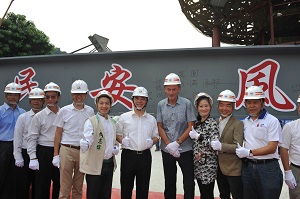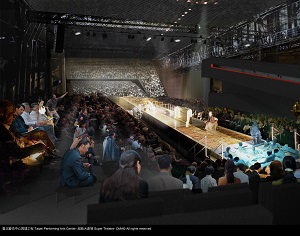Taipei Performing Arts Center by OMA tops out
By Yali Chen The TPAC site, located near the MRT Jiantan Station and famous Shilin Night Market, offers a convenient location with easy access to public transport and Taiwanese foods. It also blends into the adjacent Taipei Astronomical Museum, National Taiwan Science Education Center, Shihlin Residence, and National Palace Museum. Initiated in 2001 during President Ma Ying-jeou’s term as Taipei mayor, the TPAC will become a new cultural landmark in Taipei and function as a major venue for arts and cultural performances once it is completed by the end of 2015, Hau said. Meanwhile, the project is intended to encourage experimental theater production, with an outdoor courtyard inviting both local and international visitors to develop a wider interest in the performing arts. OMA won the competition for the TPAC in January 2009 after beating 135 entries from 24 countries. The entire TPAC team includes OMA’s Associate-in-charge Adam Frampton, plus Partners-in-charge Rem Koolhaas and David Gianotten, as well as Artech Architects founder-architect Kris Yao, senior partner-architect Willy Yu and the Artech team. Completion of the project is expected in 2015 with an estimated construction budget of NT$5.4 billion.
Staff Writer The construction of much-anticipated Taipei Performing Arts Center (TPAC) has topped out, two years after breaking ground in 2012. Taipei City Mayor Hau Lung-bin, and OMA’s Partners in charge of the project, Rem Koolhaas and David Gianotten, attended at the topping out ceremony in Taipei this past August 27. The OMA-designed TPAC is slated for completion by the end of 2015 and will begin operation in the fall of 2016.
The construction of much-anticipated Taipei Performing Arts Center (TPAC) has topped out, two years after breaking ground in 2012. Taipei City Mayor Hau Lung-bin, and OMA’s Partners in charge of the project, Rem Koolhaas and David Gianotten, attended at the topping out ceremony in Taipei this past August 27. The OMA-designed TPAC is slated for completion by the end of 2015 and will begin operation in the fall of 2016. The OMA-designed TPAC consists of three primary volumes: a 1,500-seat grand theater, an 800-seat multiform theater, and an 800-seat proscenium playhouse. Plugged into a central cube clad in corrugated glass, each of the auditoriums allows each space to function independently while sharing backstage space and mechanical facilities. Besides, the grand and multiform theaters can be combined into a “super theater,” providing a 100-meter long space for experimental theatrical projects.
The OMA-designed TPAC consists of three primary volumes: a 1,500-seat grand theater, an 800-seat multiform theater, and an 800-seat proscenium playhouse. Plugged into a central cube clad in corrugated glass, each of the auditoriums allows each space to function independently while sharing backstage space and mechanical facilities. Besides, the grand and multiform theaters can be combined into a “super theater,” providing a 100-meter long space for experimental theatrical projects.

![Taiwan.gov.tw [ open a new window]](/images/egov.png)
